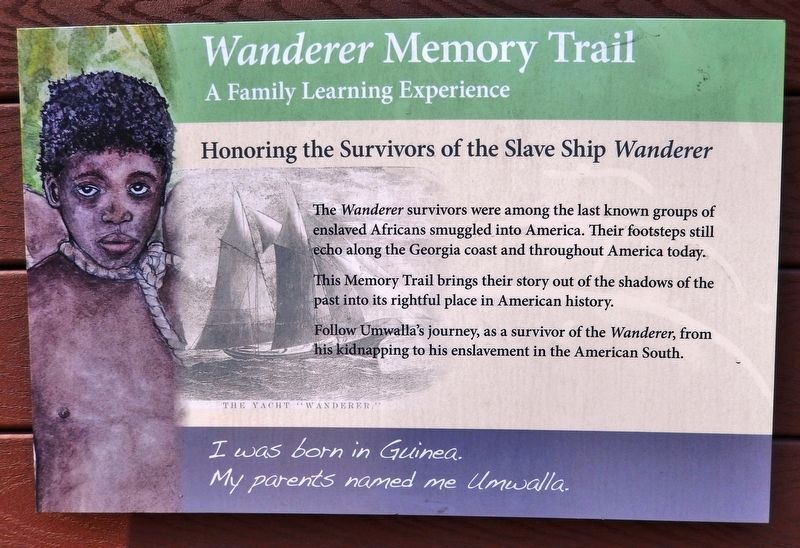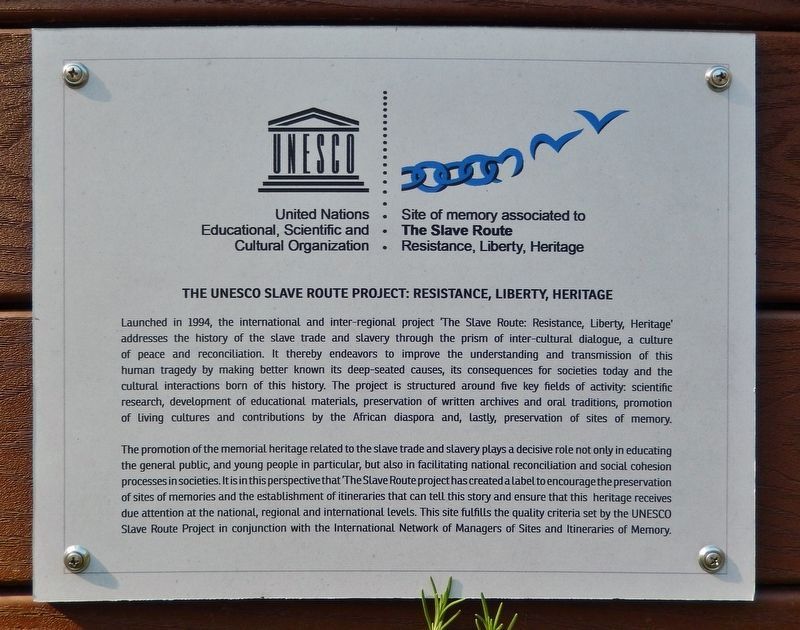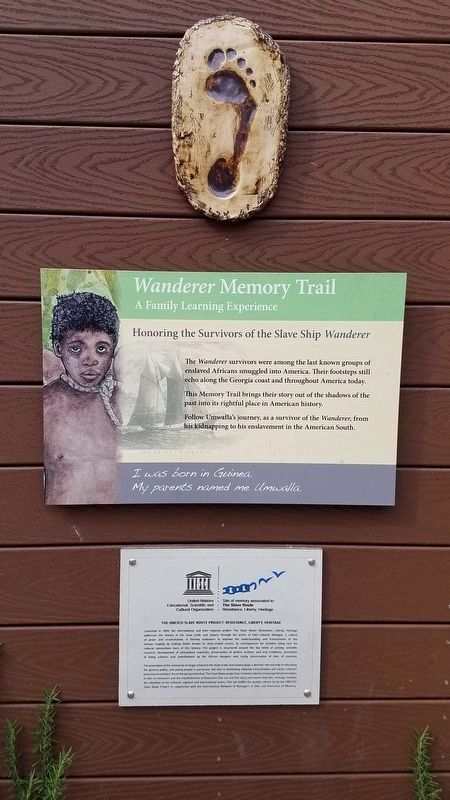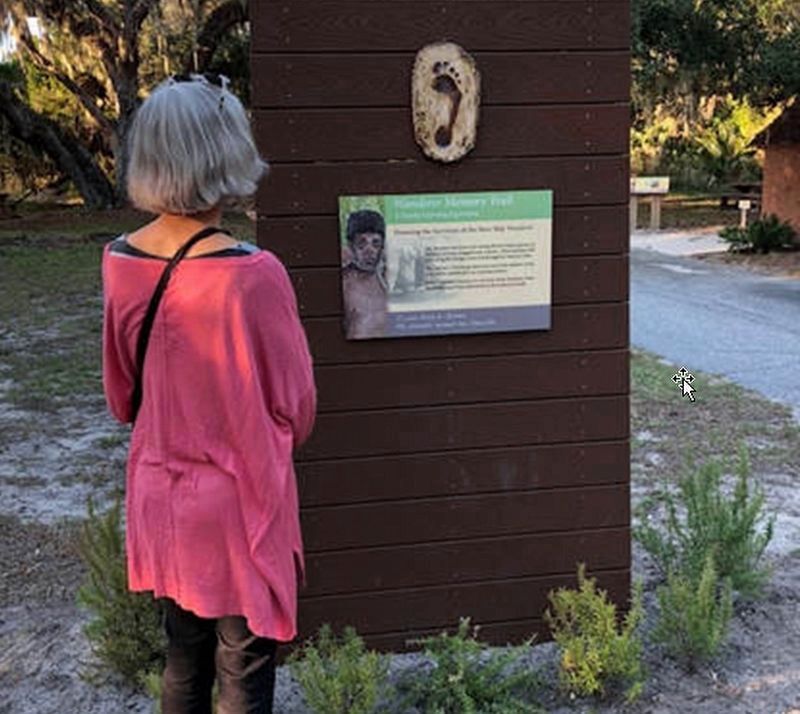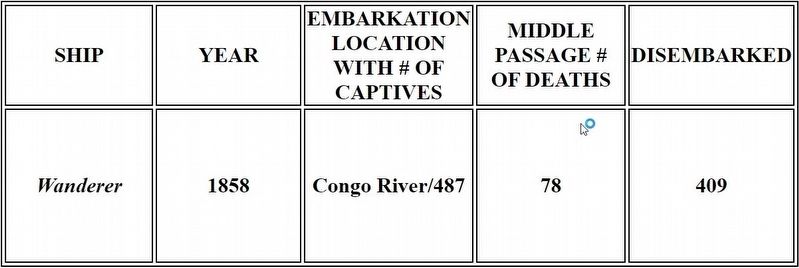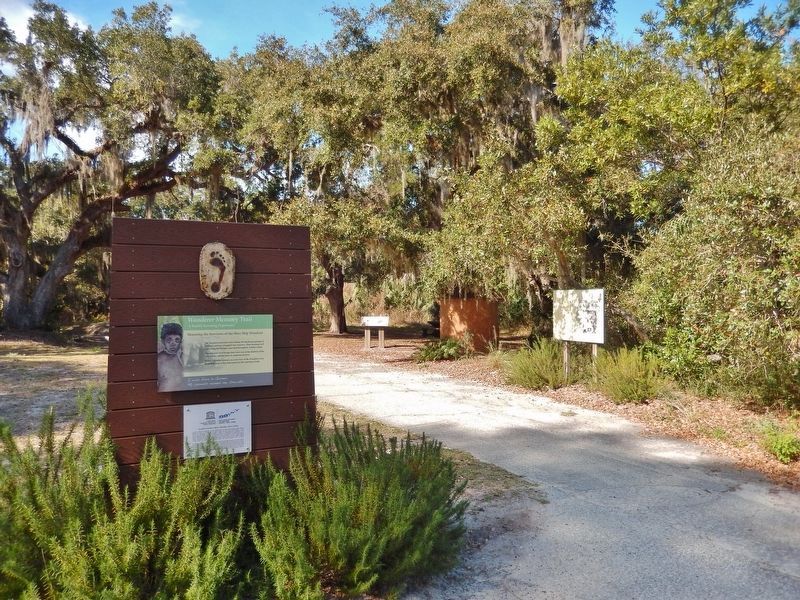Jekyll Island in Glynn County, Georgia — The American South (South Atlantic)
Wanderer Memory Trail
A Family Learning Experience
Honoring the Survivors of the Slave Ship Wanderer
The Wanderer survivors were among the last known groups of enslaved Africans smuggled into America. Their footsteps still echo along the Georgia coast and throughout America today.
This Memory Trail brings their story out of the shadows of the past and into its rightful place in American history.
Follow Umwalla’s journey, as a survivor of the Wanderer, from his kidnapping to his enslavement in the American South.
I was born in Guinea.
My parents named me Umwalla.
(plaque)
The UNESCO Slave Route Project: Resistance, Liberty, Heritage
Launched in 1994, the international and inter-regional project ‘The Slave Route: Resistance, Liberty, Heritage’ addresses the history of the slave trade and slavery through the prism of intercultural dialogue, a culture of peace and reconciliation. It thereby endeavours to improve the understanding and transmission of this human tragedy by making better known its deep-seated causes, its consequences for societies today and the cultural interactions born of this history. The project is structured around five key fields of activity: scientific research, development of educational materials, preservation of written archives and oral traditions, promotion of living cultures and contributions by the African diaspora and, lastly, preservation of sites of memory.
The promotion of the memorial heritage related to the slave trade and slavery plays a decisive role not only in educating the general public, and young people in particular, but also in facilitating national reconciliation and social cohesion processes in societies. It is in this perspective that ‘The Slave Route project has created a label to encourage the preservation of sites of memories and the establishment of itineraries that can tell this story and ensure that this heritage receives due attention at the national, regional and international levels. This site fulfils the quality criteria set by the UNESCO Slave Route Project in conjunction with the International Network of Managers of Sites and Itineraries of Memory.
Topics. This historical marker is listed in these topic lists: African Americans • Waterways & Vessels. A significant historical year for this entry is 1858.
Location. 31° 1.293′ N, 81° 26.041′ W. Marker is on Jekyll Island, Georgia, in Glynn County. Marker can be reached from the intersection of Beach View Drive and South Riverview Drive. Located near the Wanderer Memorial in St. Andrews Beach Park. Touch for map. Marker is at or near this postal address: 1 South Riverview Drive, Jekyll Island GA 31527, United States of America. Touch for directions.
Other nearby markers. At least 8 other markers are within walking distance of this marker. Survivors of the Wanderer (here, next to this marker); Taken From Africa (a few steps from this marker); Marched to the Sea (a few steps from this marker); The Wanderer — Timeline (a few steps from this marker); The Wanderer — Timeline: Continued (a few steps from this marker); The Wanderer — Cilucangy: Ward Lee (a few steps from this marker); The Wanderer — What Happened to the Survivors: Their Stories (a few steps from this marker); The Wanderer — Built For Speed (a few steps from this marker). Touch for a list and map of all markers in Jekyll Island.
Regarding Wanderer Memory Trail. In 1858, the Wanderer illegally transported more than 480 people from Angola to the United States as an investment venture. It was intercepted by the U.S. Navy, but contrary to U.S. policy after the Amistad case, none of the enslaved Africans were freed or returned to Africa. In 2008, a dedication attended by more than 500 people, including descendants of the captives, was held at the landing site. The Wanderer Memory Trail is in the same location as the original Middle Passage arrival site. The focus is upon African enslaved people and their journey from Africa to Georgia, from freedom to slavery, and later to freedom - a journey
that continues.
Related markers. Click here for a list of markers that are related to this marker. Wanderer Memory Trail
Also see . . .
1. Middle Passage Ceremonies and Port Markers Project. Project website homepage (Submitted on May 5, 2020, by John Bloomfield of Palm Coast, Florida.)
2. Enslavement. Digital History website entry:
Many Americans, influenced by images in the television mini-series "Roots," mistakenly believe that most slaves were captured by Europeans who landed on the African coast and captured or ambushed people. While Europeans did engage in some slave raiding, the majority of people who were transported to the Americas were enslaved by other Africans. It is important to understand that Europeans were incapable, on their own, of kidnapping 20 million Africans. Indeed, the system became so institutionalized that Europeans had little contact with the actual process of enslavement. (Submitted on April 3, 2021, by Byron Hooks of Sandy Springs, Georgia.)
3. What is Modern Slavery?. U.S. State Department website entry:
In 2020, Traffickers are denying nearly 25 million people their fundamental right to freedom, forcing them to live enslaved and toil for their exploiter’s profit. "Trafficking in persons,” “human trafficking,” and “modern slavery” are used as umbrella terms to refer to both sex trafficking and compelled labor. (Submitted on April 3, 2021, by Byron Hooks of Sandy Springs, Georgia.)
Additional keywords. Middle Passage, slavery, human Wanderer Memory Trail
Credits. This page was last revised on April 10, 2021. It was originally submitted on May 5, 2020, by John Bloomfield of Palm Coast, Florida. This page has been viewed 483 times since then and 49 times this year. Photos: 1, 2. submitted on March 18, 2021, by Cosmos Mariner of Cape Canaveral, Florida. 3, 4, 5. submitted on May 5, 2020, by John Bloomfield of Palm Coast, Florida. 6. submitted on March 18, 2021, by Cosmos Mariner of Cape Canaveral, Florida. • Bernard Fisher was the editor who published this page.
